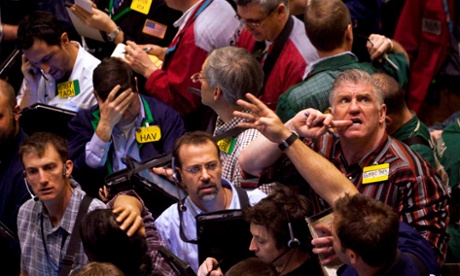The seven megatrends that could beat global warming: ‘There is reason for hope’
‘Everybody gets paralysed by bad news because they feel helpless,” says Christiana Figueres, the former UN climate chief who delivered the landmark Paris climate change agreement. “It is so in our personal lives, in our national lives and in our planetary life.”
But it is becoming increasingly clear that it does not need to be all bad news: a series of fast-moving global megatrends, spurred by trillion-dollar investments, indicates that humanity might be able to avert the worst impacts of global warming. From trends already at full steam, including renewable energy, to those just now hitting the big time, such as mass-market electric cars, to those just emerging, such as plant-based alternatives to meat, these trends show that greenhouse gas emissions can be halted.
“If we were seeing linear progress, I would say good, but we’re not going to make it in time,” says Figueres, now the convener of the Mission 2020 initiative, which warns that the world has only three years to get carbon emissions on a downward curve and on the way to beating global warming. “But the fact is we are seeing progress that is growing exponentially, and that is what gives me the most reason for hope.”
No one is saying the battle to avert catastrophic climate change – floods, droughts, famine, mass migrations – has been won. But these megatrends show the battle has not yet been lost, and that the tide is turning in the right direction. “The important thing is to reach a healthy balance where we recognise that we are seriously challenged, because we really have only three years left to reach the tipping point,” says Figueres. “But at the same time, the fact is we are already seeing many, many positive trends.”
Michael Liebreich, the founder of Bloomberg New Energy Finance, agrees. “The good news is we are way better than we thought we could be. We are not going to get through this without damage. But we can avoid the worst. I am optimistic, but there is a long way to go.”
Also cautiously hopeful is climate economist Nicholas Stern at the London School of Economics. “These trends are the start of something that might be enough – the two key words are ‘start’ and ‘might’.” He says the global climate negotiations, continuing this week in Germany and aiming to implement the Paris deal, are crucial: “The acceleration embodied in the Paris agreement is going to be critical.”
THE TRENDS
1. Methane: getting to the meat

Carbon dioxide from burning fossil fuels is the main greenhouse gas, but methane and nitrous oxide are more potent and, unlike CO2, still rising. The major source is livestock farming, in particular belching cattle and their manure.
The world’s appetite for meat and dairy foods is rising as people’s incomes rise, but the simple arithmetic is that unless this is radically curbed, there is no way to beat global warming. The task looks daunting – people hate being told what to eat. However, just in the last year, a potential solution has burst on to the market: plant-based meat, which has a tiny environmental footprint.
What sounds like an oxymoron – food that looks and tastes just as good as meat or dairy products but is made from plants – has attracted heavy investment. The buzz is particularly loud in the US, where Bill Gates has backed two plant-based burger companies and Eric Schmidt, formerly CEO of Google, believes plant-based foods can make a “meaningful dent” in tackling climate change.
Perhaps even more telling is that major meat and dairy companies are now piling in with investments and acquisitions, such as the US’s biggest meat processor, Tyson, and multinational giants Danone and Nestlé. The Chinese government has just put 0m (£228m) into Israeli companies producing lab-grown meat, which could also cut emissions.
New plant-based products, from chicken to fish to cheese, are coming out every month. “We are in the nascent stage,” says Alison Rabschnuk at the US nonprofit group the Good Food Institute. “But there’s a lot of money moving into this area.”
Plant-based meat and dairy produce is not only environmentally friendly, but also healthier and avoids animal welfare concerns, but these benefits will not make them mass-market, she says: “We don’t believe that is what is going to make people eat plant-based food. We believe the products themselves need to be competitive on taste, price and convenience – the three attributes people use when choosing what to eat.”
Plant-based milks – soya, almond, oat and more – have led the way and are now about 10% of the market and a billion-dollar business in the US. But in the past year, sales of other meat and dairy substitutes have climbed 8%, with some specific lines, such as yoghurt, shooting up 55%. “I think the writing’s on the wall,” says Rabschnuk. Billionaire entrepreneur Richard Branson agrees. “I believe that in 30 years or so we will no longer need to kill any animals and that all meat will either be [lab] or plant-based, taste the same and also be much healthier for everyone.”
2. Renewable energy: time to shine

The most advanced of the megatrends is the renewable energy revolution. Production costs for solar panels and wind turbines have plunged, by 90% in the past decade for solar, for example, and are continuing to fall. As a result, in many parts of the world they are already the cheapest electricity available and installation is soaring: two-thirds of all new power in 2016 was renewable.
This extraordinary growth has confounded expectations: the respected International Energy Agency’s annual projections have anticipated linear growth for solar power every year for the past decade. In reality, growth has been exponential. China is leading the surge but the impact is being felt around the world: in Germany last week there was so much wind power that customers got free electricity.
In the US, enthusiasm for green energy has not been dented by President Donald Trump committing to repeal key climate legislation: bn has been invested since he signed an executive order in March. “I am no longer concerned about electric power,” says Figueres.
3. King coal: dead or dying
The flipside of the renewables boom is the death spiral of coal, the filthiest of fossil fuels. Production now appears to have peaked in 2013. The speed of its demise has stunned analysts. In 2013, the IEA expected coal-burning to grow by 40% by 2040 – today it anticipates just 1%.
The cause is simple: solar and wind are cheaper. But the consequences are enormous: in pollution-choked China, there are now no provinces where new coal is needed, so the country has just mothballed plans for 151 plants. Bankruptcies have torn through the US coal industry and in the UK, where coal-burning began the industrial revolution, it has fallen from 40% of power supply to 2% in the past five years.
“Last year, I said if Asia builds what it says it is going to build, we can kiss goodbye to 2C” – the internationally agreed limit for dangerous climate change – says Liebreich. “Now we are showing coal [plans] coming down.” But he warns there is more to do.
Solar and wind are cheaper than new coal, he says, but a second tipping point is needed. That will occur when renewables are cheaper to build than running existing coal plants, meaning that the latter shut down. If renewable costs continue to fall as expected, this would happen between 2030 and 2040. At that point, says Liebrich, “Why keep digging coal out of the ground when you could just put up solar?”
4. Electric cars: in the fast lane

Slashing oil use – a third of all global energy – is a huge challenge but a surging market for battery-powered cars is starting to bite, driven in significant part by fast-growing concerns about urban air pollution.
China, again, is leading the way. It is selling as many electric cars every month as Europe and the US combined, with many from home-grown companies such as BYD. US-based Tesla is rolling out its more affordable Model 3 and in recent months virtually all major carmakers have committed to an electric future, with Volvo and Jaguar Land Rover announcing that they will end production of pure fossil-fuelled cars within three years.
“We have a domino effect now,” says Figueres. These cars are “now being made for the mass market and that is really what is going to make the transformation”.
“I don’t think it is going to slow down,” says Viktor Irle, an analyst at EV-volumes.com. Drivers can see the direction of travel, he says, with a stream of choked cities and countries from Paris to India announcing future bans on fossil-fuelled cars.
It is true that global sales of electric cars have now achieved liftoff, quadrupling in the past three years, but they still make up only 1.25% of all new car sales. However, if current growth rates continue, as Irle expects, 80% of new cars will be electric by 2030.
The rapid rise of electric cars has left the oil giants, who have a lot to lose, playing catchup. The oil cartel Opec has increased its estimate of the number of electric cars operative in 2040 by five times in the past year alone, with the IEA, ExxonMobil and BP all bumping up their forecasts too. Heavy transport remains a challenge, but even here ships are experimenting with wind power and batteries. Short-haul electric airplanes are on the drawing board, too.
5. Batteries: lots in store

Batteries are key to electric cars and, by storing energy for when the sun goes down or the wind stops blowing, they are also vital when it comes to enabling renewable energy to reach its full potential. Here too, a megatrend is crushing prices for lithium-ion batteries, which are down 75% over the past six years. The International Renewable Energy Agency expects further falls of 50-66% by 2030 and a massive increase in battery storage, linked to increasingly smart and efficient digital power grids. In the UK alone, government advisers say a smart grid could save bill-payers £8bn a year by 2030, as well as slashing carbon emissions.
Fears that lithium-ion, the technology that dominates today, cannot be scaled up sufficiently are overblown, argues Liebreich, as the metal is not rare. “I think lithium-ion is a banker in that you can be sure it will get cheaper and you can be sure there is enough.” He is also frustrated by frequent claims that a grid based on renewables and storage cannot be cheap and reliable: “That stupidity and absolute certainty is in inverse proportion to any knowledge of how you run an electrical system.”
It is true, however, that batteries will not be the solution for energy storage over weeks or months. For that, long-distance electricity interconnectors are being built and the storage of the energy as gas is also being explored.
6. Efficiency: negawatts over megawatts

Just as important as the greening of energy is reducing demand by boosting energy efficiency. It’s a no-brainer in climate policy, but it can be very tricky to make happen, as it requires action from millions of people.
Nonetheless, good progress is being made in places such as the EU, where efficiency in homes, transport and industry has improved by about 20% since 2000. Improving the efficiency of gadgets and appliances through better standards is surprisingly important: a new UN Environment Programme report shows it makes the biggest impact of any single action bar rolling out wind and solar power.
But again, continued progress is vital. “We need to drive energy efficiency very, very hard, even for European countries,” says Prof Kevin Anderson at the University of Manchester. “We could power down European energy use by about 40% in something like 10-15 years, just by making the most efficient appliances available the new minimum.”
In countries with cool winters, better insulation is also needed, particularly as a fossil fuel – natural gas – currently provides a lot of heating. “What is a crime is every time a building is renovated but not renovated to really high standards,” says Liebreich, who thinks labelling such homes as “zero-energy-bill” homes, not “zero-carbon” homes, would help overcome opposition.
One sector that is lagging on energy efficiency is industry, but technology to capture and bury CO2 from plants is being tested and ways to clean up cement-making are also being explored.
7. Forests: seeing the wood
The destruction of forests around the world for ranching and farming, as well as for timber, causes about 10% of greenhouse gas emissions. This is the biggest megatrend not yet pointing in the right direction: annual tree losses have roughly doubled since 2000.
This is particularly worrying as stopping deforestation and planting new trees is, in theory at least, among the cheapest and fastest ways of cutting carbon emissions. But it is not getting the support it needs, says Michael Wolosin at Forest Climate Analytics. “Climate policy is massively underfunding forests – they receive only about 2% of global climate finance.” Furthermore, the .3bn committed to forests by rich nations and multilateral institutions since 2010 is tiny compared with the funding for the sectors that drive deforestation. “Brazil and Indonesia’s governments alone invested 6bn in the same timeframe, in just the four key driver commodities: palm oil, soy, beef and timber,” says Franziska Haupt at Climate Focus.
In fact, new research has shown that better land management could deliver a third of all the carbon cuts the world needs, and Wolosin says there are some grounds for hope that new forests can be planted. “Achieving large-scale forestation is not just theoretical. We know we can do it because a few countries have done it successfully.”
In the past two decades, tree-planting in China, India and South Korea has removed more than 12bn tonnes of CO2 from the atmosphere – three times the entire European Union’s annual emissions, Wolosin says. This action was driven by fears about flooding and food supply, meaning that global warming needs to be seen as equally urgent in this sector. Regrowing forests can also play a crucial role in sucking CO2 out of the atmosphere, which is likely to be necessary after 2050, unless very sharp cuts are made now.
The race against time
Will these megatrends move fast enough to avoid the worst of climate change? Opinions vary and Anderson is among the most hawkish. He says it remains possible for now, but is pessimistic that the action will be taken. “We’re pointing in the right direction but not moving [there]. We have to not just pursue renewables and electric vehicles and so forth, we have to actively close down the incumbent fossil fuel industry.”
Stern is cautiously optimistic, saying that what has changed in recent years is the realisation that green economic growth is the only long-term option: “There is no long-run high-carbon growth story because it creates an environment so hostile that it turns development backwards.
“There are some tremendous developments so I am very confident now we can do this, but the change, attractive as it is, has to be radical,” he says. “Will we have the political and economic understanding and commitment to get there? I hope so.”
guardian.co.uk © Guardian News & Media Limited 2010
Published via the Guardian News Feed plugin for WordPress.


